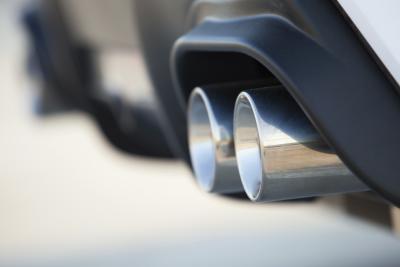
Today's automotive exhaust systems are far removed from the simple, metal tubes of vehicles past. Back then, leaks and rusted pipes were about the only real forms of failure; these days, however, catalytic converters, resonators, different muffler designs and even heat and noise shields make for a plethora of possible problems.
Exhaust leaks are usually the easiest things to find -- provided they occur upstream of the muffler -- because of the noise that often comes with them. If you're tracking down an audible leak, the safest way to do it is with the car running on a shop lift; you don't want to be crawling around under there with hot pipes spewing dangerous gases into a confined space. Generally speaking, the sharper and louder the noise, the closer the leak is to the engine. The deeper the noise, the larger the leak is. A leaking manifold gasket can be extremely loud, with pronounced cracking and popping, while a loose pipe just behind the muffler will usually be more muted, even and deeper in tone.
Back-pressure exists in almost every exhaust system, and it's a killer where performance and fuel economy are concerned. In terms of failure, it usually happens because of a collapsed catalytic converter, or internally damaged muffler. If you experience a loss of performance and suspect some kind of internal blockage, listening to the exhaust and watching the tailpipe can help you track it down. Excessive back-pressure will usually cause the exhaust to go quieter, with a more muted and "strained" tone under acceleration. Park the car, and have an assistant quickly rev the engine while you monitor the tailpipe output. An exhaust with excess back-pressure will "hesitate" after your assistant floors the throttle, building up pressure until the exhaust comes out on one, massive whoosh. If the exhaust noticeably "hesitates," and then the tailpipe quickly scatters sand and leaves like a leafblower, you may have a blockage in the system.
The simplest -- and sometimes only -- way to find the blockage is with a pressure test. The go-to starting point these days is to start by removing the downstream oxygen sensor after the converter, and screwing an exhaust pressure gauge in its place. You might see as high as 2.5 to 3 psi of back-pressure at idle, though 1 to 1.5 psi is more typical. Raise the engine rpm to about 2,500; if the pressure increases noticeably, you've likely got a blockage in the muffler or resonator. If you see no rise, put the downstream O2 sensor back in, and repeat the test with the upstream sensor, before the converter. You'll almost certainly see a higher back-pressure reading there, but it should be within 1 or 2 psi of the downstream test. If it's more than that at idle, or shoots up at higher rpm, there's a good chance you have a collapsed converter.
Assuming the second O2 sensor is working, you'll almost certainly get a check-engine light if the converter is damaged. The computer will display P0420, P0421, P0430 or P0431 when you check the diagnostic codes using any generic OBD-II scanner. However, don't assume the cat is bad by the codes alone, since sensor problems can trigger them as well. If you suspect a leak but can't hear it, you can use the old dollar-bill test. Use a pair of pliers to hold an old bill -- the older the better -- at about its center. Then, move the end of the bill around the suspect area, as close to the metal as possible -- preferably just touching it. If the end of the bill flutters when you move it over the area, you've found your leak.
Old, cigar-chomping shade-tree mechanics used to perform a similar test by blowing a thick haze of smoke around suspect areas, and watching the smoke to see if escaping exhaust gases disturbed it. Now, however, exhaust shops will usually forgo the tobacco and use a professional machine that produces UV-reactive smoke.